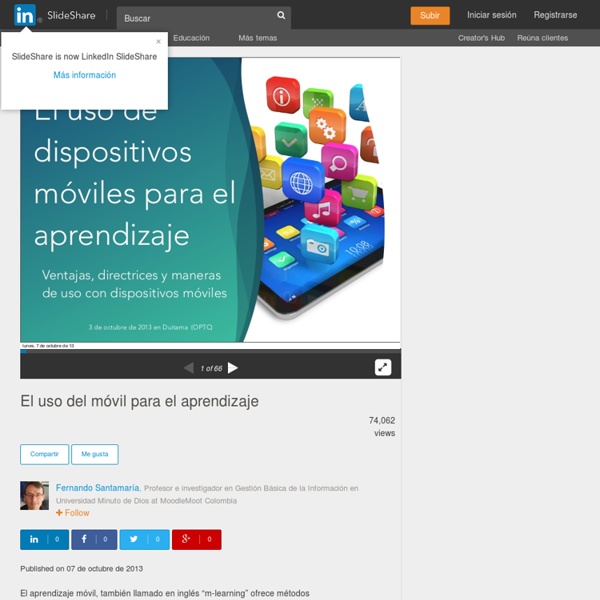



Essa Academy Aprendizaje mediante dispositivos móviles De manera incremental y dondequiera que estén, las personas esperan acceder a Internet y al rico entramado de conocimiento que éste contiene. Los dispositivos móviles, incluyendo teléfonos inteligentes y tabletas, posibilitan a sus usuarios hacer exactamente eso, vía redes de celulares o en forma inalámbrica. El número creciente de suscriptores de dispositivos móviles, unido a la evolución sin precedentes de éstos, han abierto la puerta a una miríada de usos educativos. Instituciones de aprendizaje en todo el mundo están explorando alternativas para que sus sitios Web, sus materiales educativos, sus recursos y las oportunidades que ofrecen estén todas disponibles en línea y optimizadas para dispositivos móviles. Descargue el Reporte completo en inglés haciendo clic aquí (pdf) REPORTE HORIZONTE 2013 Edición para Educación Escolar (K-12) APRENDIZAJE MEDIANTE DISPOSITIVOS MÓVILES Una muestra de aplicaciones de los dispositivos móviles trasversal a varias disciplinas, incluye las siguientes:
Aprendizaje móvil: M-Learning El último monográfico de SCOPEO: M-Learning, en España, Portugal y América Latina describe de forma bastante exhaustiva el estado actual de la cuestión referente al aprendizaje móvil, mobile learning o m-learning y su lectura ha impulsado este artículo. Este trabajo es una visión particular sobre este tipo de enseñanza-aprendizaje, centrado únicamente en tres dispositivos donde se mencionan algunas claves sobre su presente y futuro. El m-learning se define como el aprendizaje a través de dispositivos móviles pequeños, con conexión inalámbrica a Internet, como pueden ser los teléfonos móviles (celulares), tabletas (iPad y sus clones), agendas electrónicas, etc. [Wikipedia] ¿De qué entorno educativo estamos hablando? Antes de continuar hay que aclarar algunos conceptos que muchas veces no se tienen en cuenta a la hora de hablar de estos temas. Este artículo va enfocado a la educación obligatoria, es decir, la de los menores de edad -niños y adolescentes-. ¿Existe el M-Learning? Mensajería.
Grupo de trabajo de M-learning en Aulablog | Otro sitio más de Blogs de Aulablog ene 15, 2013 Proyecto Waves Leer más ene 11, 2013 Historias en Stopmotion Leer más Proyecto 02 Leer más Ver más proyectos